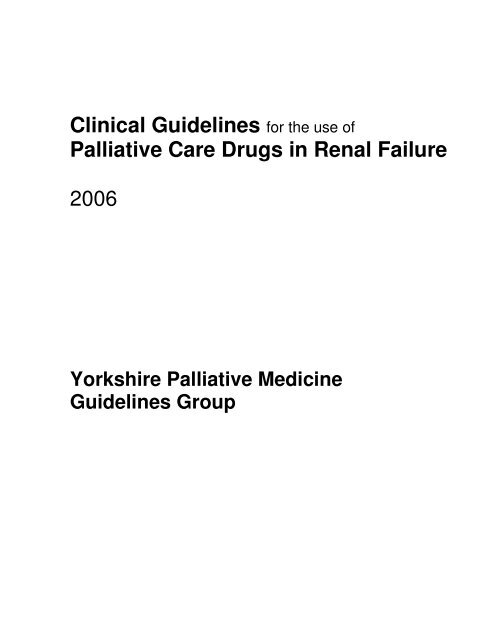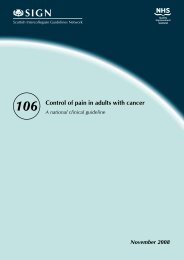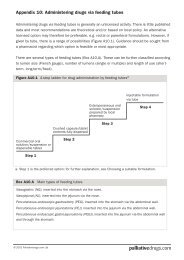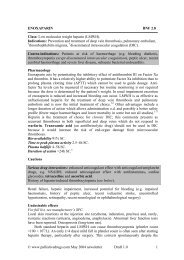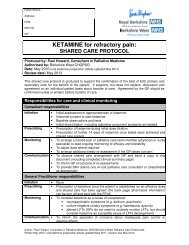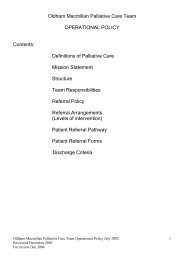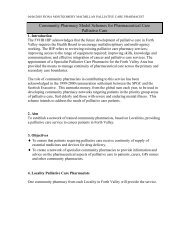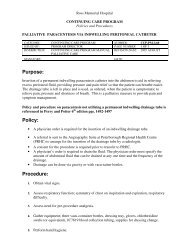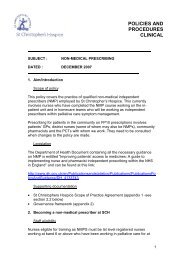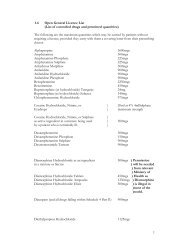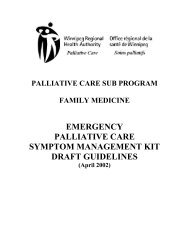Clinical Guidelines for the use of Palliative Care Drugs in Renal ...
Clinical Guidelines for the use of Palliative Care Drugs in Renal ...
Clinical Guidelines for the use of Palliative Care Drugs in Renal ...
You also want an ePaper? Increase the reach of your titles
YUMPU automatically turns print PDFs into web optimized ePapers that Google loves.
<strong>Cl<strong>in</strong>ical</strong> <strong>Guidel<strong>in</strong>es</strong> <strong>for</strong> <strong>the</strong> <strong>use</strong> <strong>of</strong><br />
<strong>Palliative</strong> <strong>Care</strong> <strong>Drugs</strong> <strong>in</strong> <strong>Renal</strong> Failure<br />
2006<br />
Yorkshire <strong>Palliative</strong> Medic<strong>in</strong>e<br />
<strong>Guidel<strong>in</strong>es</strong> Group
CONTENTS<br />
Introduction<br />
Authors 3<br />
Primary objectives<br />
Secondary objectives<br />
Review Date<br />
Compet<strong>in</strong>g <strong>in</strong>terests<br />
Disclaimer<br />
Contact Details<br />
Resources 4<br />
Abbreviations<br />
Measures <strong>of</strong> renal function 5<br />
Pharmacological considerations<br />
<strong>in</strong> renal failure and renal replacement <strong>the</strong>rapy 6<br />
Suggestions <strong>for</strong> first l<strong>in</strong>e drugs <strong>in</strong> renal failure 8<br />
Alphabetical list <strong>of</strong> drugs with specific prescrib<strong>in</strong>g advice 11<br />
Appendices<br />
I. Formulae <strong>for</strong> estimat<strong>in</strong>g GFR 23<br />
Acknowledgements<br />
II. Complete list <strong>of</strong> authors 24<br />
References<br />
2
INTRODUCTION<br />
Authors<br />
Yorkshire <strong>Palliative</strong> Medic<strong>in</strong>e <strong>Guidel<strong>in</strong>es</strong> Group chaired by Dr Annette Edwards.<br />
This project was led by:<br />
- Dr Rachel Sheils, Specialist Registrar <strong>in</strong> <strong>Palliative</strong> Medic<strong>in</strong>e<br />
- Sue Ayers, Advanced Pharmacist <strong>Palliative</strong> Medic<strong>in</strong>e and Pa<strong>in</strong>, St Gemma’s<br />
Hospice and Leeds Teach<strong>in</strong>g Hospitals NHS Trust<br />
- Dr Bel<strong>in</strong>da Batten, Consultant <strong>in</strong> <strong>Palliative</strong> Medic<strong>in</strong>e, St Ca<strong>the</strong>r<strong>in</strong>e’s Hospice,<br />
Scarborough<br />
Primary objectives<br />
1. To provide a compact <strong>for</strong>m <strong>of</strong> advice <strong>for</strong> prescrib<strong>in</strong>g palliative care drugs <strong>in</strong><br />
patients with renal failure<br />
2. To suggest which drugs from a given class – eg opioids - might be most<br />
appropriate <strong>for</strong> a patient with renal failure<br />
Secondary objectives<br />
1. To suggest <strong>the</strong> <strong>use</strong> <strong>of</strong> calculated glomerular filtration rate (GFR) as a measure<br />
<strong>of</strong> renal function, <strong>in</strong> preference to serum creat<strong>in</strong><strong>in</strong>e (Cr)<br />
2. To highlight <strong>the</strong> pros and cons <strong>of</strong> us<strong>in</strong>g different methods <strong>for</strong> estimat<strong>in</strong>g GFR <strong>in</strong><br />
palliative care patients<br />
If <strong>in</strong> doubt, or if fur<strong>the</strong>r <strong>in</strong><strong>for</strong>mation is required, please consult a renal<br />
pharmacist.<br />
Review Date: October 2010<br />
Compet<strong>in</strong>g <strong>in</strong>terests:<br />
None declared<br />
Disclaimer: These guidel<strong>in</strong>es are <strong>the</strong> property <strong>of</strong> <strong>the</strong> Yorkshire <strong>Palliative</strong> Medic<strong>in</strong>e<br />
<strong>Guidel<strong>in</strong>es</strong> Group. It is <strong>in</strong>tended that <strong>the</strong>y be <strong>use</strong>d by qualified medical and o<strong>the</strong>r<br />
healthcare pr<strong>of</strong>essionals as an <strong>in</strong><strong>for</strong>mation resource. They should be <strong>use</strong>d <strong>in</strong> <strong>the</strong><br />
cl<strong>in</strong>ical context <strong>of</strong> each <strong>in</strong>dividual patient’s needs. The Yorkshire <strong>Palliative</strong> Medic<strong>in</strong>e<br />
<strong>Cl<strong>in</strong>ical</strong> <strong>Guidel<strong>in</strong>es</strong> group takes no responsibility <strong>for</strong> any consequences <strong>of</strong> any<br />
actions taken as a result <strong>of</strong> us<strong>in</strong>g <strong>the</strong>se guidel<strong>in</strong>es.<br />
Contact Details:<br />
Dr Annette Edwards<br />
Consultant <strong>in</strong> <strong>Palliative</strong> Medic<strong>in</strong>e<br />
Leeds Teach<strong>in</strong>g Hospitals NHS Trust / Sue Ryder <strong>Care</strong> Wheatfields Hospice<br />
Grove Road<br />
Head<strong>in</strong>gley<br />
Leeds<br />
LS6 2AE<br />
Tel: 0113 2787249<br />
Email: Annette.Edwards@suerydercare.org<br />
3
RESOURCES<br />
Literature searches (Medl<strong>in</strong>e) provided few examples <strong>of</strong> similar guidel<strong>in</strong>es. Those that<br />
were identified conta<strong>in</strong>ed advice <strong>for</strong> adjust<strong>in</strong>g doses, but <strong>of</strong>ten, this advice did not<br />
appear to be <strong>in</strong> keep<strong>in</strong>g with <strong>the</strong> pharmacok<strong>in</strong>etic <strong>in</strong><strong>for</strong>mation provided.<br />
This document condenses exist<strong>in</strong>g resources <strong>in</strong> order to make <strong>the</strong> <strong>in</strong><strong>for</strong>mation more<br />
accessible at <strong>the</strong> patient’s bedside.<br />
We <strong>use</strong>d <strong>the</strong> follow<strong>in</strong>g resources (<strong>in</strong> order <strong>of</strong> authority):<br />
1. Specification <strong>of</strong> Product Characteristics (SPC or data sheet)<br />
(available from www.emc.medic<strong>in</strong>es.org.uk)<br />
2. The <strong>Renal</strong> Drug Handbook, Second Edition<br />
3. <strong>Palliative</strong> <strong>Care</strong> Formulary, Second Edition<br />
4. British National Formulary 50<br />
5. Micromedex (available from www.micromedex.com – password required)<br />
6. dialog datastar<br />
Medl<strong>in</strong>e & Embase<br />
search by – drug & renal failure (with <strong>the</strong>saurus mapp<strong>in</strong>g)<br />
7. NSF <strong>for</strong> renal services – Part two: chronic kidney disease, acute renal failure and<br />
end <strong>of</strong> life care<br />
Full references <strong>for</strong> <strong>the</strong> above resources can be found <strong>in</strong> appendix II<br />
In general, once <strong>in</strong><strong>for</strong>mation was obta<strong>in</strong>ed from a given resource, we did not go on to<br />
search resources <strong>of</strong> lower authority <strong>for</strong> <strong>the</strong> same <strong>in</strong><strong>for</strong>mation. Where o<strong>the</strong>r sources<br />
gave more conservative advice than <strong>the</strong> SPC, we have <strong>in</strong>cluded and highlighted <strong>the</strong><br />
conflict<strong>in</strong>g <strong>in</strong><strong>for</strong>mation <strong>in</strong> yellow <strong>in</strong> <strong>the</strong> table.<br />
Abbreviations<br />
CAV/VVHD…Cont<strong>in</strong>uous arterio-venous/ veno-venous haemodiafiltration<br />
CG…………..Cockcr<strong>of</strong>t Gault<br />
Cr……………serum Creat<strong>in</strong><strong>in</strong>e<br />
Cr Cl………...Creat<strong>in</strong><strong>in</strong>e Clearance<br />
eGFR………..estimated Glomerular Filtration Rate<br />
GFR…………Glomerular Filtration Rate<br />
HD…………...Haemodialysis<br />
HF…………...Haem<strong>of</strong>iltration<br />
Max………….Maximum<br />
MDRD….......Modification <strong>of</strong> Diet <strong>in</strong> <strong>Renal</strong> Disease<br />
NSF…………National Service Framework<br />
PD…………..Peritoneal Dialysis<br />
Rx……………Treatment<br />
SPC…………Specification <strong>of</strong> Product Characteristics<br />
O<strong>the</strong>r abbreviations are standard, or are def<strong>in</strong>ed <strong>in</strong> <strong>the</strong> A-Z drug list tables.<br />
4
MEASURES OF RENAL FUNCTION<br />
Traditionally, serum creat<strong>in</strong><strong>in</strong>e has been <strong>use</strong>d by many health pr<strong>of</strong>essionals as a<br />
measure <strong>of</strong> renal function. This is <strong>in</strong>accurate as patients may have a cl<strong>in</strong>ically<br />
significant deterioration <strong>in</strong> renal function while still hav<strong>in</strong>g a serum creat<strong>in</strong><strong>in</strong>e with<strong>in</strong> <strong>the</strong><br />
normal reference range. (Lamb et al 2005)<br />
Historically, some branches <strong>of</strong> medic<strong>in</strong>e have recognised <strong>the</strong> need <strong>for</strong> more accurate<br />
measures <strong>of</strong> renal function, and creat<strong>in</strong><strong>in</strong>e clearance (CrCl) has been <strong>use</strong>d.<br />
Increas<strong>in</strong>gly, it is recognised that glomerular filtration rate (GFR) is a preferable<br />
measure <strong>of</strong> renal function (NSF <strong>for</strong> renal services – Part two, 2005). While this can be<br />
measured with <strong>in</strong>vasive techniques (<strong>in</strong>ul<strong>in</strong> clearance), <strong>the</strong>re are two generally accepted<br />
ways <strong>of</strong> estimat<strong>in</strong>g GFR.<br />
These are:<br />
1. The Cockcr<strong>of</strong>t & Gault equation (CG)<br />
2. 4 variant Modification <strong>of</strong> Diet <strong>in</strong> <strong>Renal</strong> Disease equation (4vMDRD)<br />
Appendix 1 gives details <strong>of</strong> <strong>the</strong>se equations and how <strong>the</strong>y have been derived.<br />
• Both methods are <strong>in</strong>accurate, especially at extremes <strong>of</strong> age and body habitus, but <strong>the</strong><br />
Cockcr<strong>of</strong>t Gault <strong>for</strong>mula is recommended when modify<strong>in</strong>g prescrib<strong>in</strong>g <strong>in</strong> renal failure.<br />
• Normal GFR is between 100 and 130 ml/m<strong>in</strong> <strong>in</strong> an adult. (Rely<strong>in</strong>g on serum<br />
creat<strong>in</strong><strong>in</strong>e will fail to identify 50% <strong>of</strong> patients with a GFR <strong>of</strong> 15 – 30ml/m<strong>in</strong>/1.73m 2 ).<br />
• <strong>Renal</strong> function can deteriorate from day to day, so <strong>the</strong> latest blood results must<br />
be <strong>use</strong>d when calculat<strong>in</strong>g GFR<br />
The relative merits <strong>of</strong> <strong>the</strong> two methods are as follows:<br />
4v MDRD<br />
COCKCROFT & GAULT<br />
Track Record Only recently developed The majority <strong>of</strong> data sheets issued by drug<br />
companies suggest dos<strong>in</strong>g changes based<br />
on GFRs calculated by Cockr<strong>of</strong>t and Gault.<br />
In patients with normal or<br />
mildly<br />
impaired renal function<br />
In patients with<br />
moderately to severely<br />
impaired renal function<br />
Body weight<br />
Accuracy poor<br />
Accuracy improves as GFR falls<br />
UNDERestimates GFR<br />
More accurate than CG<br />
Not required<br />
Required<br />
NB when modify<strong>in</strong>g drug doses, GFR calculated<br />
us<strong>in</strong>g 4vMDRD must be adjusted <strong>for</strong> patient’s<br />
total surface area<br />
Accuracy poor<br />
Accuracy improves as GFR falls<br />
OVERestimates GFR<br />
Cachexia<br />
(BMI
PHARMACOLOGICAL CONSIDERATIONS IN RENAL<br />
FAILURE AND RENAL REPLACEMENT THERAPY<br />
DRUG CLEARANCE<br />
In general, drugs are cleared by:<br />
• excretion (most <strong>of</strong>ten via <strong>the</strong> ur<strong>in</strong>e, but can also be excreted via bile or faeces)<br />
• metabolism to an active or <strong>in</strong>active <strong>for</strong>m (usually <strong>in</strong> <strong>the</strong> liver)<br />
• a comb<strong>in</strong>ation <strong>of</strong> metabolism and excretion<br />
When metabolism and/or excretion are impaired, <strong>the</strong> dose or frequency <strong>of</strong><br />
adm<strong>in</strong>istration <strong>of</strong> drugs may need to be altered to prevent accumulation <strong>of</strong> drugs. It is<br />
important to remember that some metabolites are active (ie have a similar effect to <strong>the</strong><br />
orig<strong>in</strong>al drug). Active metabolites can be cleared ei<strong>the</strong>r by fur<strong>the</strong>r metabolism, or by<br />
excretion <strong>in</strong> <strong>the</strong> ur<strong>in</strong>e.<br />
HOW THE KIDNEYS REMOVE DRUGS<br />
<strong>Drugs</strong> are delivered to <strong>the</strong> kidney via circulat<strong>in</strong>g blood. The blood is filtered, and <strong>the</strong><br />
filtrate will eventually become ur<strong>in</strong>e after modification <strong>in</strong> <strong>the</strong> kidney tubule.<br />
At <strong>the</strong> kidney, drugs may undergo any <strong>of</strong> <strong>the</strong> follow<strong>in</strong>g:<br />
• Filtration<br />
- A given drug may or may not be filtered.<br />
- The larger <strong>the</strong> drug molecule, <strong>the</strong> less likely it is to be filtered. If a drug is<br />
bound to prote<strong>in</strong>, it effectively becomes a larger molecule.<br />
• Secretion<br />
- This occurs when <strong>the</strong> kidney actively pumps a substance from <strong>the</strong> blood <strong>in</strong>to<br />
<strong>the</strong> fluid that will become ur<strong>in</strong>e. (This is <strong>in</strong> contrast to filtration which is a<br />
passive process.)<br />
• Reabsorption<br />
- This occurs when a substance is actively pumped back <strong>in</strong>to <strong>the</strong> blood from <strong>the</strong><br />
fluid that will become ur<strong>in</strong>e, regardless <strong>of</strong> whe<strong>the</strong>r <strong>the</strong> drug entered <strong>the</strong> fluid<br />
by filtration or excretion.<br />
When renal function is impaired, <strong>the</strong> rate <strong>of</strong> filtration at <strong>the</strong> kidney (GFR) is reduced.<br />
There<strong>for</strong>e, drugs which rely on renal clearance will take longer to clear.<br />
OTHER CONSIDERATIONS<br />
<strong>Renal</strong> failure can make patients more susceptible to adverse effects <strong>of</strong> drugs.<br />
In particular it ca<strong>use</strong>s:<br />
- an <strong>in</strong>creased bleed<strong>in</strong>g tendency, <strong>the</strong>re<strong>for</strong>e <strong>the</strong> risks <strong>of</strong> NSAIDs and anticoagulants<br />
are <strong>in</strong>creased<br />
- <strong>in</strong>creased blood bra<strong>in</strong> barrier permeability, and <strong>the</strong>re<strong>for</strong>e <strong>in</strong>creased sensitivity to<br />
CNS side effects <strong>of</strong> drugs (eg sedation).<br />
6
RENAL REPLACEMENT THERAPY<br />
This comprises haemodialysis, peritoneal dialysis and haem<strong>of</strong>iltration.<br />
Haem<strong>of</strong>iltration (HF) <strong>in</strong>volves pass<strong>in</strong>g <strong>the</strong> patient’s blood through an external<br />
mach<strong>in</strong>e with a syn<strong>the</strong>tic membrane. Fluids and o<strong>the</strong>r substances (<strong>in</strong>clud<strong>in</strong>g some<br />
drugs) cross <strong>the</strong> membrane by convection. This is <strong>use</strong>d <strong>in</strong> acute ra<strong>the</strong>r than chronic<br />
renal failure and is usually run cont<strong>in</strong>uously <strong>for</strong> a number <strong>of</strong> days.<br />
Haemodialysis (HD) <strong>in</strong>volves pass<strong>in</strong>g <strong>the</strong> patient’s blood through an external mach<strong>in</strong>e<br />
with a syn<strong>the</strong>tic membrane. However, fluids and o<strong>the</strong>r substances (<strong>in</strong>clud<strong>in</strong>g some<br />
drugs) cross <strong>the</strong> membrane along a concentration gradient. This is <strong>use</strong>d <strong>in</strong>termittently<br />
(<strong>of</strong>ten <strong>for</strong> ~ 4 hours, 2 or 3 times/week) <strong>in</strong> chronic renal failure.<br />
Peritoneal dialysis (PD) <strong>in</strong>volves pass<strong>in</strong>g fluid <strong>in</strong>to <strong>the</strong> peritoneal cavity, and allow<strong>in</strong>g<br />
fluid and some substances to cross <strong>the</strong> peritoneal membrane along a concentration<br />
gradient. The fluid is <strong>the</strong>n dra<strong>in</strong>ed back out <strong>of</strong> <strong>the</strong> peritoneal cavity. It is <strong>use</strong>d <strong>in</strong><br />
chronic renal failure, and has <strong>the</strong> advantage that patients can do it at home.<br />
DRUG CLEARANCE IN RENAL REPLACEMENT THERAPY<br />
Drug clearance <strong>in</strong> renal replacement <strong>the</strong>rapy is affected by <strong>the</strong> follow<strong>in</strong>g factors:<br />
Properties <strong>of</strong> <strong>the</strong> drug<br />
Delivery <strong>of</strong> drug to <strong>the</strong> filter<br />
Properties <strong>of</strong> <strong>the</strong> filter<br />
If <strong>the</strong> drug molecule is larger than <strong>the</strong> pore size <strong>of</strong> <strong>the</strong> membrane, <strong>the</strong>n it will not be<br />
cleared by dialysis. If <strong>the</strong> drug has a large volume <strong>of</strong> distribution throughout <strong>the</strong> body<br />
(and <strong>the</strong>re<strong>for</strong>e only a small percentage <strong>of</strong> it is <strong>in</strong> <strong>the</strong> circulation) it will be poorly cleared<br />
by dialysis.<br />
In general:<br />
- If a drug is avidly cleared by a particular type <strong>of</strong> dialysis, it would<br />
have to be adm<strong>in</strong>istered after dialysis <strong>in</strong> order <strong>for</strong> it to have <strong>the</strong><br />
desired effect.<br />
- If a drug is poorly cleared by a particular type <strong>of</strong> dialysis, dos<strong>in</strong>g<br />
and frequency <strong>of</strong> medication should be altered <strong>in</strong> keep<strong>in</strong>g with <strong>the</strong><br />
underly<strong>in</strong>g renal function. GFR should be assumed to be less than<br />
15 ml/m<strong>in</strong>. Serum creat<strong>in</strong><strong>in</strong>e levels are reduced immediately after<br />
dialysis and <strong>the</strong>re<strong>for</strong>e do not reflect GFR.<br />
7
SUGGESTED FIRST LINE DRUGS IN RENAL FAILURE<br />
• The suggestions below only apply when renal failure is <strong>the</strong> ma<strong>in</strong> factor <strong>in</strong> decid<strong>in</strong>g<br />
which drug (<strong>in</strong> a given class) to <strong>use</strong>.<br />
• The reasons <strong>for</strong> suggest<strong>in</strong>g <strong>the</strong>se drugs may <strong>in</strong>clude:<br />
1. Clearance (and <strong>the</strong>re<strong>for</strong>e dos<strong>in</strong>g) is relatively unaffected by renal impairment;<br />
2. The drug’s mechanism <strong>of</strong> action has specific benefit <strong>in</strong> renal impairment<br />
and/or<br />
3. The drug is relatively less nephrotoxic (NB not important once a patient<br />
becomes anuric)<br />
• There will be occasions where o<strong>the</strong>r considerations become more important than<br />
renal failure. For example, a particular drug may be preferable beca<strong>use</strong> <strong>of</strong> a<br />
beneficial side effect pr<strong>of</strong>ile, even though it would require significant dose<br />
adjustment. In such circumstances, please refer to <strong>the</strong> alphabetical list <strong>of</strong> drugs<br />
(pages 11-22) <strong>for</strong> prescrib<strong>in</strong>g advice.<br />
• It should be remembered that <strong>the</strong> central nervous system effects <strong>of</strong> any drug can<br />
be <strong>in</strong>creased <strong>in</strong> renal failure, even if drug clearance is not affected.<br />
ANTICOAGULANTS<br />
For GFR
BISPHOSPHONATES<br />
First choice is debatable beca<strong>use</strong> <strong>the</strong> <strong>in</strong><strong>for</strong>mation from different sources is<br />
conflict<strong>in</strong>g.<br />
There is evidence to suggest that pamidronate and zoledronate can be nephrotoxic.<br />
There is no evidence to suggest ibandronic acid (Ibandronate) is nephrotoxic, but, it is a<br />
newer drug. For <strong>in</strong>dividual patients, potential harm from underly<strong>in</strong>g conditions<br />
(hypercalcaemia or prevention <strong>of</strong> skeletal related events) must be weighed aga<strong>in</strong>st<br />
potential harm from <strong>the</strong> drug. Ibandronate may be <strong>the</strong> drug <strong>of</strong> choice when it is<br />
unacceptable to risk any worsen<strong>in</strong>g <strong>of</strong> a patient’s renal function.<br />
If GFR 10-30<br />
Zoledronate: should not be <strong>use</strong>d.<br />
Ibandronate: The data sheet suggests that Ibandronate can be <strong>use</strong>d <strong>in</strong> reduced doses.<br />
However, Micromedex advises aga<strong>in</strong>st its <strong>use</strong>.<br />
Pamidronate: This can be <strong>use</strong>d <strong>in</strong> normal doses <strong>for</strong> GFRs above 10, but with a<br />
prolonged <strong>in</strong>fusion time.<br />
If GFR
NSAIDS<br />
As a group, NSAIDs can be nephrotoxic and should be <strong>use</strong>d with extreme caution,<br />
particularly <strong>in</strong> patients with moderate to severe renal impairment unless <strong>the</strong>re are no<br />
alternatives and dependent upon <strong>the</strong> cl<strong>in</strong>ical situation (eg <strong>the</strong> last few days <strong>of</strong> life).<br />
NSAIDs (with PPI cover) can still be <strong>use</strong>d <strong>in</strong> dialysis patients if <strong>the</strong>y have no significant<br />
residual renal function (eg anuric patients)<br />
The most hazardous NSAID <strong>in</strong> renal failure is ketorolac. O<strong>the</strong>rwise, no NSAID is<br />
recommended over any o<strong>the</strong>r.<br />
NB<br />
• Damage to <strong>the</strong> kidneys from nephrotoxic drugs (<strong>in</strong>clud<strong>in</strong>g NSAIDs) is additive.<br />
• Increased bleed<strong>in</strong>g tendency <strong>in</strong> people with renal failure <strong>in</strong>creases <strong>the</strong> risk <strong>of</strong> GI<br />
bleed<strong>in</strong>g.<br />
• Sul<strong>in</strong>dac was once thought to be <strong>the</strong> most spar<strong>in</strong>g <strong>of</strong> <strong>the</strong> NSAIDs on renal<br />
prostagland<strong>in</strong> <strong>in</strong>hibition and hence least nephrotoxic. However, <strong>for</strong> doses<br />
>100mg BD <strong>the</strong>re is no evidence to support this. (Brater 1999)<br />
OPIOIDS<br />
Morph<strong>in</strong>e should be avoided as it accumulates <strong>in</strong> renal failure and can ca<strong>use</strong> overopiation.<br />
If not us<strong>in</strong>g subcutaneous route, consider transdermal route <strong>for</strong> background analgesia,<br />
with oral PRN medication.<br />
• Subcutaneous: Alfentanil (no dose adjustment required)<br />
• Transdermal:<br />
- Buprenorph<strong>in</strong>e (still a small risk <strong>of</strong> accumulat<strong>in</strong>g weakly active metabolite)<br />
- Fentanyl (especially if high dose opioid required, but greater risk <strong>of</strong><br />
accumulation)<br />
• Oral:<br />
- For GFR 10-50: Oxycodone<br />
- For GFR
<strong>Cl<strong>in</strong>ical</strong> <strong>Guidel<strong>in</strong>es</strong> <strong>for</strong> In<strong>for</strong>mation is from <strong>in</strong>dividual data sheets, except, <strong>in</strong> blue = <strong>Renal</strong> Drug Handbook 2 nd<br />
PALLIATIVE CARE DRUGS IN RENAL FAILURE Edition, <strong>in</strong> p<strong>in</strong>k = <strong>Renal</strong> Drug Handbook – Draft 3 rd edition and <strong>in</strong> green = Micromedex.<br />
All o<strong>the</strong>r references are specified.<br />
DRUG<br />
Alfentanil Several <strong>in</strong>clud<strong>in</strong>g<br />
Noralfentanil (?I),<br />
glucoronides(I)<br />
(liver)<br />
Amitriptyl<strong>in</strong>e Nortriptyl<strong>in</strong>e (A) 10-<br />
hydroxyamitriptyl<strong>in</strong>e<br />
(A)<br />
10-<br />
hydroxynortriptyl<strong>in</strong>e<br />
(A)<br />
<strong>Renal</strong> (D,M)<br />
only 1 % unchanged<br />
<strong>Renal</strong><br />
D 65yrs,<br />
deranged liver function.<br />
Normal dose<br />
BUT BEWARE INCREASED RISK<br />
OF SEDATION IN RENAL<br />
FAILURE<br />
>30 10-30
<strong>Cl<strong>in</strong>ical</strong> <strong>Guidel<strong>in</strong>es</strong> <strong>for</strong> In<strong>for</strong>mation is from <strong>in</strong>dividual data sheets, except, <strong>in</strong> blue = <strong>Renal</strong> Drug Handbook 2 nd<br />
PALLIATIVE CARE DRUGS IN RENAL FAILURE Edition, and <strong>in</strong> green = Micromedex. All o<strong>the</strong>r references are specified.<br />
DRUG<br />
Citalopram<br />
Clarithromyc<strong>in</strong><br />
Clonazepam<br />
Co-danthramer<br />
Code<strong>in</strong>e<br />
Cycliz<strong>in</strong>e<br />
METABOLITES<br />
(A=active,<br />
I=<strong>in</strong>active)<br />
Demethylcitalopram<br />
(A);<br />
Didemethylcitalopram<br />
(A); citalopram-Noxide<br />
(A); deam<strong>in</strong>ated<br />
propionic acid<br />
derivative (I)<br />
14 hydroxy<br />
metabolite (A)<br />
7-am<strong>in</strong>o-clonazepam<br />
(I)<br />
7-acetylam<strong>in</strong>oclonazepam<br />
(I)<br />
3-hydroxyclonazepam<br />
(A)<br />
Dantron part<br />
metabolised by GI<br />
flora, both D and M<br />
adsorbed.<br />
Glucuronide and<br />
sulphate metabolites<br />
(Breimer et al 1976)<br />
C6G (A), Norcode<strong>in</strong>e<br />
(?),Morph<strong>in</strong>e (A)<br />
M3G (I)M6G (A)<br />
Hepatic metabolism<br />
n-demethylated to<br />
norcycliz<strong>in</strong>e [I]<br />
ELIMINATION<br />
(D=drug,<br />
M=metabolites)<br />
Hepatic<br />
85%<br />
<strong>Renal</strong><br />
D - 12%<br />
Faecal70-80%(M)<br />
Ur<strong>in</strong>e 20-30% (D)<br />
<strong>Renal</strong> (D)<br />
<strong>Cl<strong>in</strong>ical</strong> <strong>Guidel<strong>in</strong>es</strong> <strong>for</strong> In<strong>for</strong>mation is from <strong>in</strong>dividual data sheets, except, <strong>in</strong> blue = <strong>Renal</strong> Drug Handbook 2 nd<br />
PALLIATIVE CARE DRUGS IN RENAL FAILURE Edition, and <strong>in</strong> green = Micromedex. All o<strong>the</strong>r references are specified.<br />
DRUG<br />
Daltepar<strong>in</strong> <strong>Renal</strong><br />
Dexamethasone<br />
Diamorph<strong>in</strong>e<br />
Diazepam<br />
Dicl<strong>of</strong>enac<br />
Docusate<br />
Sodium<br />
METABOLITES<br />
(A=active,<br />
I=<strong>in</strong>active)<br />
Various<br />
metabolites(I)<br />
6MAM (?A), M6G<br />
(A)<br />
a. N-desmethyl<br />
diazepam (A)<br />
b. Temazepam (A)<br />
a & b both converted<br />
to Oxazepam (A)<br />
Hydroxylated <strong>in</strong>to<br />
<strong>in</strong>active metabolite<br />
(liver) (I)<br />
ELIMINATION<br />
(D=drug,<br />
M=metabolites)<br />
20-50
<strong>Cl<strong>in</strong>ical</strong> <strong>Guidel<strong>in</strong>es</strong> <strong>for</strong> In<strong>for</strong>mation is from <strong>in</strong>dividual data sheets, except, <strong>in</strong> blue = <strong>Renal</strong> Drug Handbook 2 nd<br />
PALLIATIVE CARE DRUGS IN RENAL FAILURE Edition, and <strong>in</strong> green = Micromedex. All o<strong>the</strong>r references are specified.<br />
DRUG<br />
Enoxapar<strong>in</strong><br />
METABOLITES<br />
(A=active,<br />
I=<strong>in</strong>active)<br />
ELIMINATION<br />
(D=drug,<br />
M=metabolites)<br />
Erythromyc<strong>in</strong> Biliary(D)<br />
Fentanyl Norfentalyl (I) D – 9% faecal<br />
D,M - 75% renal<br />
Flucloxacill<strong>in</strong> <strong>Renal</strong> (D)<br />
Fluconazole<br />
Fluoxet<strong>in</strong>e<br />
1,2,3-triazole and<br />
o<strong>the</strong>rs (liver – poor<br />
metab)<br />
Norfluoxet<strong>in</strong>e (A)<br />
(and o<strong>the</strong>r<br />
unidentified M)<br />
<strong>Renal</strong> D,M<br />
(approx. 80%<br />
unchanged)<br />
Ur<strong>in</strong>e
<strong>Cl<strong>in</strong>ical</strong> <strong>Guidel<strong>in</strong>es</strong> <strong>for</strong> In<strong>for</strong>mation is from <strong>in</strong>dividual data sheets, except, <strong>in</strong> blue = <strong>Renal</strong> Drug Handbook 2 nd<br />
PALLIATIVE CARE DRUGS IN RENAL FAILURE Edition, <strong>in</strong> p<strong>in</strong>k = <strong>Renal</strong> Drug Handbook – Draft 3 rd edition and <strong>in</strong> green = Micromedex.<br />
All o<strong>the</strong>r references are specified.<br />
DRUG<br />
METABOLITES<br />
(A=active,<br />
I=<strong>in</strong>active)<br />
ELIMINATION<br />
(D=drug,<br />
M=metabolites)<br />
Glycopyrrolate No <strong>in</strong><strong>for</strong>mation D = 48.5% renal<br />
rema<strong>in</strong>der unchanged <strong>in</strong><br />
bile<br />
Granisetron<br />
Hepatic metabolism<br />
(? Activity)<br />
<strong>Renal</strong> 59% [D,M]<br />
Faecal rema<strong>in</strong>der [M]<br />
Dose/<strong>in</strong>terval change<br />
<strong>in</strong> renal failure<br />
Dose/<strong>in</strong>terval change <strong>in</strong><br />
renal replacement Rx<br />
NEPHRO<br />
TOXIC?<br />
OTHER<br />
GFR<br />
HF PD HD<br />
(Y/N)<br />
No <strong>in</strong><strong>for</strong>mation available No <strong>in</strong><strong>for</strong>mation available N Antichol<strong>in</strong>ergic – may ca<strong>use</strong> ur<strong>in</strong>ary retention<br />
Normal dose Normal<br />
dose<br />
Normal<br />
dose<br />
*<br />
N<br />
Dose is titrated aga<strong>in</strong>st effect.<br />
Some accumulation possible<br />
*Manufacturer recommends tim<strong>in</strong>g <strong>of</strong> HD<br />
should be more than 2 hrs after granisetron.<br />
Haloperidol<br />
Hydromorphone<br />
Hyosc<strong>in</strong>e<br />
Butylbromide<br />
Hepatic metabolism<br />
Hydroxylhaloperidol<br />
[A]<br />
<strong>Renal</strong> and faecal<br />
Dihydroisomorph<strong>in</strong>e<br />
(A),<br />
<strong>Renal</strong>(D,M)<br />
dihydromorph<strong>in</strong>e<br />
(A), H3G (I)<br />
? a) D –50% renal<br />
excretion<br />
10-50
<strong>Cl<strong>in</strong>ical</strong> <strong>Guidel<strong>in</strong>es</strong> <strong>for</strong> In<strong>for</strong>mation is from <strong>in</strong>dividual data sheets, except, <strong>in</strong> blue = <strong>Renal</strong> Drug Handbook 2 nd<br />
PALLIATIVE CARE DRUGS IN RENAL FAILURE Edition, <strong>in</strong> p<strong>in</strong>k = <strong>Renal</strong> Drug Handbook – Draft 3 rd edition and <strong>in</strong> green = Micromedex.<br />
All o<strong>the</strong>r references are specified.<br />
DRUG<br />
Ibupr<strong>of</strong>en<br />
Ketam<strong>in</strong>e<br />
Ketorolac<br />
Lactulose<br />
METABOLITES<br />
(A=active,<br />
I=<strong>in</strong>active)<br />
Liver metabolism to<br />
<strong>in</strong>active conjugates (I)<br />
Nor-ketam<strong>in</strong>e (A)<br />
dehydronor-ketam<strong>in</strong>e<br />
(I)<br />
Hydroxylated <strong>in</strong>to<br />
<strong>in</strong>active metabolite (I)<br />
Lactic acid (A)<br />
Formic acid (A)<br />
Acetic acid (A)<br />
ELIMINATION<br />
(D=drug,<br />
M=metabolites)<br />
<strong>Renal</strong><br />
D
<strong>Cl<strong>in</strong>ical</strong> <strong>Guidel<strong>in</strong>es</strong> <strong>for</strong> In<strong>for</strong>mation is from <strong>in</strong>dividual data sheets, except, <strong>in</strong> blue = <strong>Renal</strong> Drug Handbook 2 nd<br />
PALLIATIVE CARE DRUGS IN RENAL FAILURE Edition, <strong>in</strong> p<strong>in</strong>k = <strong>Renal</strong> Drug Handbook – Draft 3 rd edition and <strong>in</strong> green = Micromedex.<br />
All o<strong>the</strong>r references are specified.<br />
DRUG<br />
METABOLITES<br />
(A=active,<br />
I=<strong>in</strong>active)<br />
Megestrol M = glucuronide<br />
conjugates<br />
Methadone<br />
Methlyphenidate<br />
Several <strong>in</strong>cl. EDDP (I)<br />
(liver)<br />
rital<strong>in</strong>ic acid (PPAA)<br />
(I)<br />
+ Hydroxymethlyphenidate<br />
(I)<br />
+<br />
hydroxyrital<strong>in</strong>ic acid<br />
(I)<br />
Hepatic<br />
Metabolites [I]<br />
Metronidazole 2-<br />
hydroxymetronidazole<br />
(A)<br />
Midazolam α-hydroxy midazolam<br />
(A)<br />
Mirtazap<strong>in</strong>e<br />
8-hydroxy (I)<br />
N-demethyl (A)<br />
N-oxide (I)<br />
ELIMINATION<br />
(D=drug,<br />
M=metabolites)<br />
D – mean 66.4% renal +<br />
mean 19.8% faecal<br />
M – 5-8% <strong>in</strong> ur<strong>in</strong>e<br />
Dose/<strong>in</strong>terval change<br />
<strong>in</strong> renal failure<br />
Dose/<strong>in</strong>terval change <strong>in</strong><br />
renal replacement Rx<br />
GFR HF PD HD<br />
No <strong>in</strong><strong>for</strong>mation available. Reduced<br />
dose would seem most likely<br />
appropriate due to high renal<br />
clearance <strong>of</strong> drug.<br />
Faecal<br />
10-50
<strong>Cl<strong>in</strong>ical</strong> <strong>Guidel<strong>in</strong>es</strong> <strong>for</strong> In<strong>for</strong>mation is from <strong>in</strong>dividual data sheets, except, <strong>in</strong> blue = <strong>Renal</strong> Drug Handbook 2 nd<br />
PALLIATIVE CARE DRUGS IN RENAL FAILURE Edition, and <strong>in</strong> green = Micromedex. All o<strong>the</strong>r references are specified.<br />
DRUG<br />
Morph<strong>in</strong>e<br />
METABOLITES<br />
(A=active,<br />
I=<strong>in</strong>active)<br />
M3G (I)<br />
M6G (A)<br />
ELIMINATION<br />
(D=drug,<br />
M=metabolites)<br />
<strong>Renal</strong> (D,M)<br />
Movicol None Faecal (D)<br />
Not significantly absorbed<br />
Dose/<strong>in</strong>terval change<br />
<strong>in</strong> renal failure<br />
GFR HF PD HD<br />
(Y/N)<br />
Dose as <strong>for</strong> GFR
<strong>Cl<strong>in</strong>ical</strong> <strong>Guidel<strong>in</strong>es</strong> <strong>for</strong> In<strong>for</strong>mation is from <strong>in</strong>dividual data sheets, except, <strong>in</strong> blue = <strong>Renal</strong> Drug Handbook 2 nd<br />
PALLIATIVE CARE DRUGS IN RENAL FAILURE Edition, and <strong>in</strong> green = Micromedex. All o<strong>the</strong>r references are specified.<br />
DRUG<br />
METABOLITES<br />
(A=active,<br />
I=<strong>in</strong>active)<br />
ELIMINATION<br />
(D=drug,<br />
M=metabolites)<br />
Dose/<strong>in</strong>terval change<br />
<strong>in</strong> renal failure<br />
GFR<br />
Dose/<strong>in</strong>terval change <strong>in</strong><br />
<strong>Renal</strong> replacement Rx<br />
HF PD HD<br />
NEPHRO<br />
TOXIC?<br />
(Y/N)<br />
OTHER<br />
Pamidronate Not metabolised <strong>Renal</strong> 20-55% (D)<br />
10-50 4: give<br />
60mg<br />
Serum Ca
<strong>Cl<strong>in</strong>ical</strong> <strong>Guidel<strong>in</strong>es</strong> <strong>for</strong> In<strong>for</strong>mation is from <strong>in</strong>dividual data sheets, except, <strong>in</strong> blue = <strong>Renal</strong> Drug Handbook 2 nd<br />
PALLIATIVE CARE DRUGS IN RENAL FAILURE Edition, and <strong>in</strong> green = Micromedex. All o<strong>the</strong>r references are specified.<br />
DRUG<br />
Piroxicam<br />
Prednisolone<br />
Pregabal<strong>in</strong><br />
Risperidone<br />
Hydroxylation <strong>the</strong>n<br />
glucuronic acid<br />
conjugation (I)<br />
Glucuronide (I)<br />
Sulphate (I)<br />
Conjugated (I)<br />
N-methylated<br />
derivative (major)<br />
9-hydroxyrisperidone<br />
(A)<br />
(liver –CYP2D6)<br />
5-10% excreted <strong>in</strong> ur<strong>in</strong>e<br />
unchanged – rest renal<br />
excretion <strong>of</strong> metabolite<br />
20-50 10-20
<strong>Cl<strong>in</strong>ical</strong> <strong>Guidel<strong>in</strong>es</strong> <strong>for</strong> In<strong>for</strong>mation is from <strong>in</strong>dividual data sheets, except, <strong>in</strong> blue = <strong>Renal</strong> Drug Handbook 2 nd<br />
PALLIATIVE CARE DRUGS IN RENAL FAILURE Edition, and <strong>in</strong> green = Micromedex. All o<strong>the</strong>r references are specified.<br />
DRUG<br />
T<strong>in</strong>zapar<strong>in</strong> Inactive <strong>Renal</strong> (D)<br />
Tramadol<br />
METABOLITES<br />
(A=active,<br />
I=<strong>in</strong>active)<br />
O-desmethyl-tramadol<br />
(A)<br />
N-desmethyl-tramadol<br />
(A)<br />
ELIMINATION<br />
(D=drug,<br />
M=metabolites)<br />
<strong>Renal</strong> (D,M) 90%<br />
Faecal(D) 10%<br />
Dose/<strong>in</strong>terval change<br />
<strong>in</strong> renal failure<br />
30-50
<strong>Cl<strong>in</strong>ical</strong> <strong>Guidel<strong>in</strong>es</strong> <strong>for</strong> In<strong>for</strong>mation is from <strong>in</strong>dividual data sheets, except, <strong>in</strong> blue = <strong>Renal</strong> Drug Handbook 2 nd<br />
PALLIATIVE CARE DRUGS IN RENAL FAILURE Edition, and <strong>in</strong> green = Micromedex. All o<strong>the</strong>r references are specified.<br />
DRUG<br />
METABOLITES<br />
(A=active,<br />
I=<strong>in</strong>active)<br />
Venlafax<strong>in</strong>e O-<br />
desmethylvenlafax<strong>in</strong>e<br />
(A)<br />
ELIMINATION<br />
(D=drug,<br />
M=metabolites)<br />
Hepatic (D)<br />
extensive 1 st pass metabolism<br />
by CP450 [CYP2D6]<br />
Dose/<strong>in</strong>terval change<br />
<strong>in</strong> renal failure<br />
>30 10-30
APPENDIX I:<br />
Formulae <strong>for</strong> calculat<strong>in</strong>g eGFR<br />
Cockcr<strong>of</strong>t Gault (Cockcr<strong>of</strong>t & Gault 1976)<br />
• Equation derived from a study <strong>of</strong> 236 <strong>in</strong>patients<br />
• The mean <strong>of</strong> 2 serum creat<strong>in</strong><strong>in</strong>e measurements and <strong>the</strong> mean <strong>of</strong> two 24hr<br />
ur<strong>in</strong>e collections <strong>for</strong> Cr Clearance were compared with measured GFR<br />
• Found that age, weight and creat<strong>in</strong><strong>in</strong>e could be <strong>use</strong>d to estimate <strong>the</strong><br />
measured creat<strong>in</strong><strong>in</strong>e clearance<br />
Estimated GFR = [140 – age(years)] x wt (kg) X 0.85 if female<br />
(ml/m<strong>in</strong>) serum creat<strong>in</strong><strong>in</strong>e (µmol/litre) x 0.814<br />
4-variable MDRD (Levy et al 1999)<br />
• Equation derived from ano<strong>the</strong>r study: “Modification <strong>of</strong> Diet <strong>in</strong> <strong>Renal</strong> Disease”<br />
(orig<strong>in</strong>ally designed to assess <strong>the</strong> effect <strong>of</strong> prote<strong>in</strong> <strong>in</strong>take and treatment <strong>of</strong><br />
hypertension on progression <strong>of</strong> renal disease)<br />
• 1070 (<strong>of</strong> 1628 patients <strong>in</strong> orig<strong>in</strong>al study) <strong>use</strong>d <strong>for</strong> model<strong>in</strong>g equation<br />
• Six ma<strong>in</strong> factors were identified. Of <strong>the</strong>se, serum urea and album<strong>in</strong> were<br />
excluded due to m<strong>in</strong>imal effect on accuracy.<br />
• An estimated GFR reported by a laboratory must be adjusted to take account<br />
<strong>of</strong> <strong>the</strong> patient’s body surface area.<br />
Estimated GFR = 186 x [Cr (µmol/litre) x 0.011312] -1.154 x [Age] -0.203<br />
(ml/m<strong>in</strong>/1.73m 2 )<br />
x [0.742 if female]<br />
x [1.212 if Afro-Caribbean ]<br />
4-variable MDRD tables are available <strong>for</strong> quick reference at<br />
http://www.renal.org/CKDguide/full/Conciseguid141205.pdf (pages 15-18)<br />
Acknowledgements<br />
The cl<strong>in</strong>ical guidel<strong>in</strong>es group is most grateful to Kathryn Ramskill, renal<br />
pharmacist and Dr Mooney, consultant nephrologist, St James’s University Hospital,<br />
who have k<strong>in</strong>dly provided support and advice dur<strong>in</strong>g <strong>the</strong> development <strong>of</strong> this document.<br />
23
APPENDIX II:<br />
Complete List <strong>of</strong> Authors<br />
Consultants <strong>in</strong> <strong>Palliative</strong> Medic<strong>in</strong>e<br />
Dr Bel<strong>in</strong>da Batten<br />
Dr Annette Edwards<br />
Dr Lynne Russon<br />
Advanced Pharmacist <strong>in</strong> <strong>Palliative</strong> <strong>Care</strong> and Pa<strong>in</strong><br />
Sue Ayers<br />
Specialist Registrars <strong>in</strong> <strong>Palliative</strong> Medic<strong>in</strong>e<br />
Dr Jeena Ackroyd<br />
Dr Liz Brown<br />
Dr Bill Hulme<br />
Dr Kath Lambert<br />
Dr Ia<strong>in</strong> Lawrie<br />
Dr Hannah Leahy<br />
Dr Steve Oxberry<br />
Dr Kirsten Saharia<br />
Dr Car<strong>in</strong>a Saxby<br />
Dr Rachel Sheils<br />
Dr Rachel Sorley<br />
Dr Paul Taylor<br />
References<br />
1. Ashley C, Currie A (eds). 2004. The <strong>Renal</strong> Drug Handbook Second Edition. Ox<strong>for</strong>d:<br />
Radcliffe Medical Press.<br />
2. Brater DC. Effects <strong>of</strong> nonsteroidal anti-<strong>in</strong>flammatory drugs on renal function: focus on<br />
cyclooxygenase-2-selective <strong>in</strong>hibition. Am J Med 1999;107(6A):65S—71S.<br />
3. Breimer DD et al, Pharmacok<strong>in</strong>etics and metabolism <strong>of</strong> anthraqu<strong>in</strong>one laxatives.<br />
Pharmacology 14 (suppl.1):30-47, 1976<br />
4. Cockcr<strong>of</strong>t DW, Gault MH: Prediction <strong>of</strong> creat<strong>in</strong><strong>in</strong>e clearance from serum creat<strong>in</strong><strong>in</strong>e.<br />
Nephron 16 : 31-41, 1976<br />
5. Devaney A, Ashley C, Tomson C. How <strong>the</strong> reclassification <strong>of</strong> kidney disease impacts on<br />
dos<strong>in</strong>g adjustments. Pharmaceutical Journal 277: 403-405, 2006<br />
6. Department <strong>of</strong> Health. NSF <strong>for</strong> renal services – Part two, 2005: chronic kidney disease,<br />
acute renal failure and end <strong>of</strong> life care. 2005<br />
7. Froissart M, Rossert J, Christian Jacquot C, Michel Paillard M, Houillier P. Predictive<br />
Per<strong>for</strong>mance <strong>of</strong> <strong>the</strong> Modification <strong>of</strong> Diet <strong>in</strong> <strong>Renal</strong> Disease and Cockcr<strong>of</strong>t-Gault<br />
Equations <strong>for</strong> Estimat<strong>in</strong>g <strong>Renal</strong> Function. J Am Soc Nephrol 16: 763-773, 2005<br />
8. Lamb, Tomson, Roderick. Annals <strong>of</strong> <strong>Cl<strong>in</strong>ical</strong> Biochemistry. 42 (5): 321-345, 2005<br />
9. Levey AS, Bosch JP, Lewis JB, Greene T, Rogers N, Roth D: A more accurate method<br />
to estimate glomerular filtration rate from serum creat<strong>in</strong><strong>in</strong>e: A new prediction equation.<br />
Modification <strong>of</strong> Diet <strong>in</strong> <strong>Renal</strong> Disease Study Group. Ann Intern Med 130 : 461-470, 1999<br />
10. Mehta D (eds). 2005. British National Formulary. London: Pharmaceutical Press<br />
11. Twycross R, Wilcock A, Thorp S (eds). 2002. <strong>Palliative</strong> <strong>Care</strong> Formulary Second<br />
Edition. Ab<strong>in</strong>gdon: Radcliffe Medical Press.<br />
24


